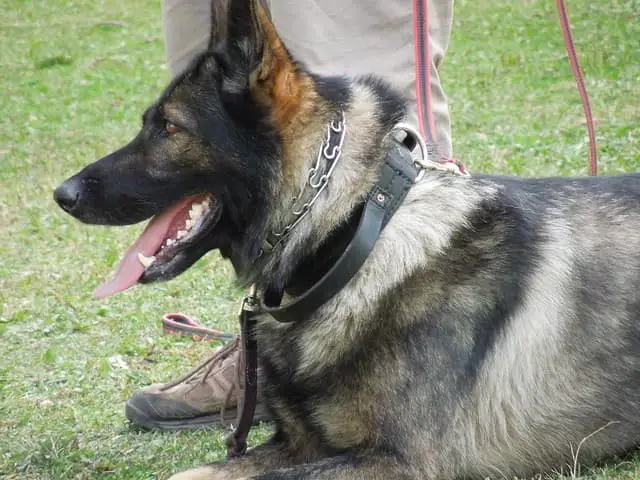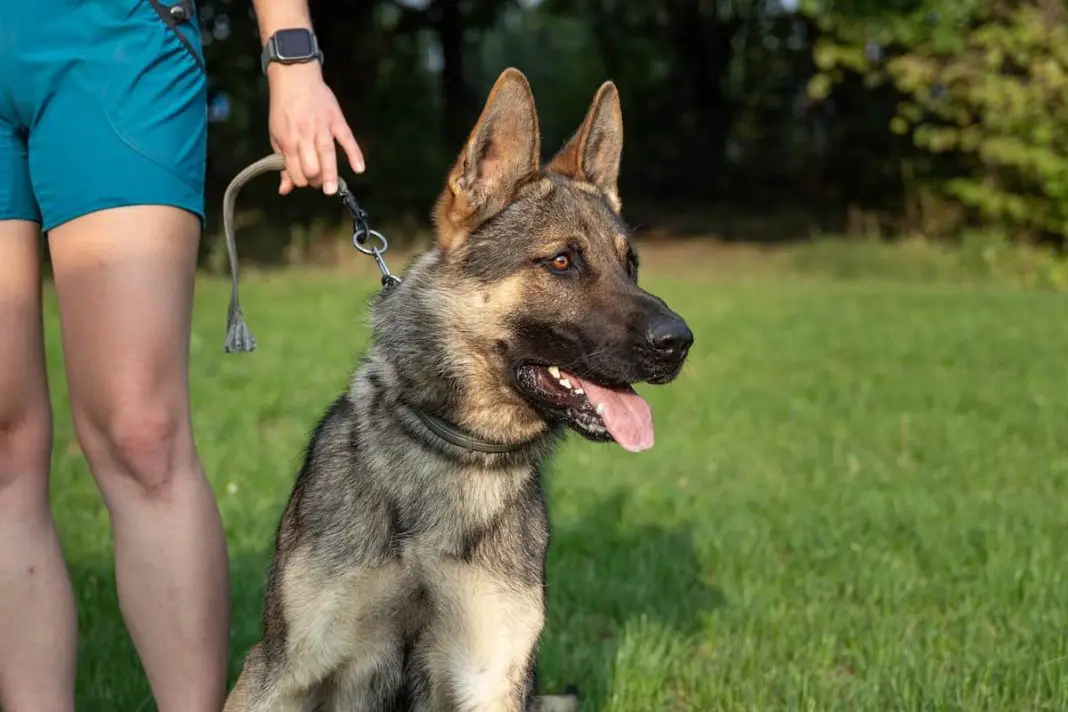If you’re trying to use a prong collar to stop your dog from pulling but you’ve released that the collar isn’t working as well as you’d hoped then there’s a good chance that the prong collar isn’t properly sized or fitted around the dog’s neck well enough. When using a prong collar, the dog should respond immediately and self-adjust quickly.
Getting The Right Fit
The biggest mistake made by those who are unfamiliar with using a prong collar is having the collar too loose. In order for a prong collar to work properly, it must fit very snugly. If it isn’t, it’ll end up creating a pressure point at the front of the dog’s neck – their most vulnerable area! When it’s kept firm, the prong collar can tighten evenly around the entire dog’s neck, greatly reducing the risk of discomfort to your dog.
An important rule of thumb for properly fitting the prong collar is that it shouldn’t be able to slip over your dog’s head. You need to connect and disconnect it each time you put on or take off the collar. If you’re able to slip the prong collar over your dog’s head and onto its neck, then it’s far too loose and you could cause your dog harm in the long term.
When a prong collar is misused, it will cause the dog an unnecessary amount of discomfort and can even cause internal injuries to your dog’s esophagus. Many people that use these collars are uncomfortable keeping the collar tight on their dog and feel like a loose collar is more humane. It’s not! In fact, people who do this are unintentionally causing their dog unnecessary pain and it could even result in serious injuries to their dog. Although prong collar training is extremely effective with pretty much any dog, it’s also a dangerous collar when it’s misused. Unfortunately, prong collars are misused a lot.

Properly Fitting A Prong Collar
If you have a prong collar, you need to understand that it will come loose at some point. It’s not a matter of if, it’s only a matter of when. You can use another collar which is loose enough so as to not restrict the prong collar, while tight enough so that if the prong collar does come loose, you’ll still have control over your dog with the normal collar. This is one of the biggest drawbacks of using a prong collar and is especially true with quick-release prong collars.
Training Your Dog With A Prong Collar
Now that you understand how a prong collar should be fitted on your dog, we can be sure that using a prong collar during training won’t cause your dog any pain or physical harm. We’ll cover how to use the prong collar gently.
Getting The Proper Fit
Now that your dog has associated the prong collar with contentment and is comfortable with it around their neck, it’s time to get the right fit.
You may need to remove some of the prongs until it has a snug fit. It’s vital that the prong collar fits snugly around the dog’s neck, just behind the ears and jawline – up high on the neck.
It’s also important to know when it’s appropriate to use the prong collar or not. After all, you don’t want the dog to act one way when the collar is on and another way when the collar is off. It’s quite common for a dog to behave perfectly while wearing a prong collar, but once the prong collar comes off, the dog goes right back to behaving poorly. This happens because the dog hasn’t been desensitized to the collar. When using a prong collar for training, it’s very important to desensitize the dog.
How Do You Desensitize A Dog To A Prong Collar?
You can do this by simply putting the collar on and taking it off randomly throughout the day. After a while, the collar will have no meaning for the dog. If a dog still has some anxiety towards the collar, try to associate putting the collar on with enticing activities that the dog enjoys, such as before feeding breakfast or dinner. The overall goal here is to get your dog to forget about the collar entirely. That way, when there’s a correction, the dog will know the correction is coming from you and not the collar.
We just spent all that time getting the dog to associate the prong collar with fun and excitement. That part was only necessary during the first step so that the dog could be slowly introduced to the collar and not become afraid of it. Now that you know that your dog isn’t fearful of the collar, the next step is to desensitize the dog to the collar.
It’s best to put the prong collar on your dog for at least 20 minutes before using it for training. Likewise, after training, you’ll want to wait 20 minutes after using a prong collar before taking it off. Your dog shouldn’t associate the prong collar with any particular event. If you notice your dog getting very excited when you bring the prong collar out, you need to do some more desensitizing.
Teaching The Rules
So, at this point, your dog should be comfortable wearing the collar, have the collar properly sized for your dog, only use the collar when appropriate, and you’ve desensitized your dog to the prong collar. Now it’s time to put the prong collar to use!
When a prong collar is used, the dog must understand that corrections are caused because of the actions that they take. You certainly don’t want a dog who feels powerless or confused by a correction. You want the dog to feel confident and have a clear understanding of what their owner expects. The key here is to communicate with your dog. There’s no point in punishing your dog. You want the dog to feel in control of whether praise or discomfort occurs. Once the rules are clearly laid out and the dog understands what causes a correction, how it can avoid a correction, and how to discontinue corrections in the future, you can start to communicate to your dog in a way that’s quick and easy to understand. You want the dog to be able to understand what a correction means, but your dog will understand how to prevent a correction in the first place. This means, within a very short period of time, you hopefully won’t have to correct your dog at all and eventually, the prong collar can be phased out. After all, a prong collar is not a lifelong collar for a dog. It’s only used for training and communicating basic rules. Once the dog has a full understanding of the rules, then the prong collar has done its job.
Conclusion
Using a prong collar correctly means that you and your dog have nothing to lose and everything to gain. While it’s controversial, the most important thing is that it’s safe and effective, it will allow you and your dog to enjoy life more, and when used in conjunction with positive reinforcement techniques, training should be an enjoyable experience which will only strengthen the bond you have with your dog.









